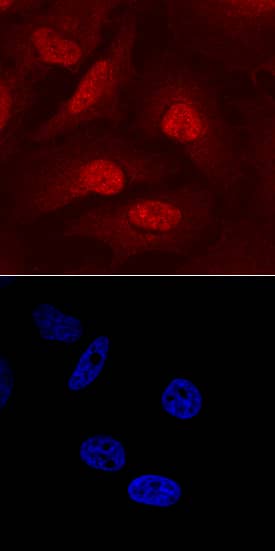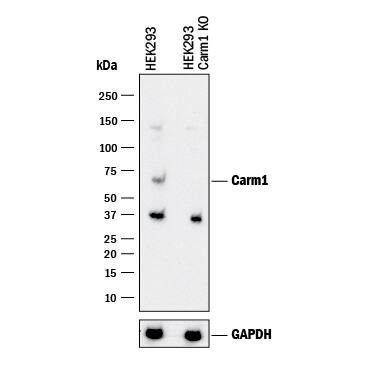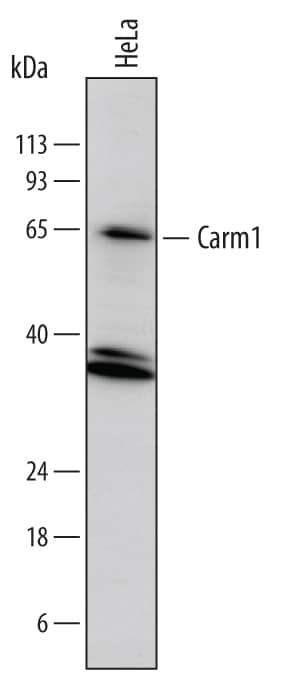Human/Mouse Carm1 Antibody
R&D Systems, part of Bio-Techne | Catalog # AF7277

Key Product Details
Validated by
Species Reactivity
Applications
Label
Antibody Source
Product Specifications
Immunogen
Lys209-Leu379
Accession # Q86X55
Specificity
Clonality
Host
Isotype
Scientific Data Images for Human/Mouse Carm1 Antibody
Detection of Human Carm1 by Western Blot.
Western blot shows lysates of HeLa human cervical epithelial carcinoma cell line. PVDF membrane was probed with 1 µg/mL of Goat Anti-Human Carm1 Antigen Affinity-purified Polyclonal Antibody (Catalog # AF7277) followed by HRP-conjugated Anti-Goat IgG Secondary Antibody (Catalog # HAF017). A specific band was detected for Carm1 at approximately 63 kDa (as indicated). This experiment was conducted under reducing conditions and using Immunoblot Buffer Group 1.Carm1 in HeLa Human Cell Line.
Carm1 was detected in immersion fixed HeLa human cervical epithelial carcinoma cell line using Goat Anti-Human Carm1 Antigen Affinity-purified Polyclonal Antibody (Catalog # AF7277) at 10 µg/mL for 3 hours at room temperature. Cells were stained using the NorthernLights™ 557-conjugated Anti-Goat IgG Secondary Antibody (red, upper panel; Catalog # NL001) and counterstained with DAPI (blue, lower panel). Specific staining was localized to nuclei and cytoplasm. View our protocol for Fluorescent ICC Staining of Cells on Coverslips.Western Blot Shows Human Carm1 Specificity by Using Knockout Cell Line.
Western blot shows lysates of HEK293 human embryonic kidney parental cell line and Carm1 knockout HEK293 cell line (KO). PVDF membrane was probed with 1 µg/mL of Goat Anti-Human/Mouse Carm1 Antigen Affinity-purified Polyclonal Antibody (Catalog # AF7277) followed by HRP-conjugated Anti-Goat IgG Secondary Antibody (Catalog # HAF017). A specific band was detected for Carm1 at approximately 65 kDa (as indicated) in the parental HEK293 cell line, but is not detectable in knockout HEK293 cell line. GAPDH (Catalog # AF5718) is shown as a loading control. This experiment was conducted under reducing conditions and using Immunoblot Buffer Group 1.Applications for Human/Mouse Carm1 Antibody
Immunocytochemistry
Sample: Immersion fixed HeLa human cervical epithelial carcinoma cell line
Knockout Validated
Western Blot
Sample: HeLa human cervical epithelial carcinoma cell line
Formulation, Preparation, and Storage
Purification
Reconstitution
Formulation
Shipping
Stability & Storage
- 12 months from date of receipt, -20 to -70 °C as supplied.
- 1 month, 2 to 8 °C under sterile conditions after reconstitution.
- 6 months, -20 to -70 °C under sterile conditions after reconstitution.
Background: Carm1
Carm1 (Coactivator-associated arginine methyltransferase 1; also PRMT4) is a 60-64 kDa member of the Arg N-methyltransferase family of enzymes. It is ubiquitously expressed, and found in the cytoplasm during mitosis, and in the nucleus during the G1, G2 and S phases of the cell cycle. Carm1 binds to nuclear receptor p160 family coactivators. When bound, it methylates DNA-associated histone H3 arginines, allowing for chromatin remodeling and gene activation. It also plays a role in pre-mRNA splicing through its methylation of splicing factors, and regulates the stability of RNA-binding proteins. Human Carm1 is 608 amino acids (aa) in length. It contains one catalytic site between aa 184-394, and a transactivation domain at the C-terminus (aa 499-608). There is one automethylation site at Arg550, and a phosphorylation site at Ser216 that, when utilized, promotes cytosolic localization. Carm1 likely forms homodimers. There are three potential isoform variants. One shows an alternative start site at Met378, a second possesses a 16 aa substitution for aa 369-608, and a third contains a deletion of aa 539-561. Over aa 209-379, human and mouse Carm1 are identical in aa sequence.
Long Name
Alternate Names
Gene Symbol
UniProt
Additional Carm1 Products
Product Documents for Human/Mouse Carm1 Antibody
Product Specific Notices for Human/Mouse Carm1 Antibody
For research use only


